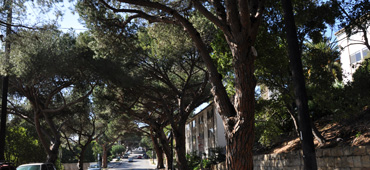

Contributor

Last year, on my way to the California Urban Forestry Conference, as I was shuttled across town to my rental car, I responded to the driver’s inevitable questions: Where was I going and why? The young driver, a recent business grad, had never heard of urban forestry. I wasn’t surprised.
Trees are the best monuments that a man can erect to his own memory. They speak his praises without flattery, and they are blessings to children yet unborn.
—Lord Orrery

Most people think of wilderness or national parks when they hear the word forestry. So it is understandably foreign to relate forests with cities. But urban forestry is the practice of managing trees, as a collective population, in urban settings. Trees along streets, in parks, along medians, and even on private property make up the urban forest. A view of a well-landscaped city from above is very helpful in understanding the concept.
As we drove, we passed streets lined with the arching canopies of camphor trees, the massive pale trunks and structured branches of majestic ficus, as well as oaks, bottlebrush, eucalyptus, pines, and evergreen pears. Just the mere sight of these trees should give people pause, I thought. These trees weren’t accidental. Someone had to select, plant, and maintain this wonderful and diverse array of species. Wasn’t it evident that planning was employed? Trees planted without forethought often resemble an afterthought, and that wasn’t the case here.

Pointing out the window, I alluded to the trees’ natural beauty, their intricate and varied structures, subtle and contrasting colors, even the dappled sunlight at their feet. What would this urban landscape look like without trees? What type of feelings would a street devoid of trees engender?
Trees are good. Most everyone would agree. But their rich complexity can lead to confusion and doubt about their correct identity, worthiness, habits, and true characteristics. So questions persist: Which tree should I plant? How can I identify that tree? Where can I buy the trees I need?
Selecting the right tree can be a daunting task. Homeowners are often overwhelmed and end up choosing a tree not because it’s the best fit, but because of easy availability, reduced price, or based on a single characteristic like flower color. Unfortunately, rushing into a purchase can result in years of dissatisfaction for a homeowner and less than optimal consequences for the tree. Knowing the characteristics and needs of a tree, and matching those to the growing site are essential for a successful planting and outcome.

Luckily, assistance is at your fingertips. Literally. California Polytechnic (Cal Poly) State University’s Urban Forest Ecosystems Institute (UFEI) can help. The UFEI website offers information on tree selection, identification, maintenance, and hazards. A page on the site even celebrates California’s biggest trees.

One such project was SelecTree, a tree selection guide for California. First published in 1995 as a Master’s project, it now earns top ranking on web searches as an online resource. SelecTree lists over 1,500 trees and shrubs accompanied by high-quality images and detailed information on tree characteristics.

SelecTree offers search options by both name and characteristics. Searching by name couldn’t be easier—simply start typing a name, common or scientific, and it will be automatically completed for you. Don’t remember the latest name for a tree? No problem. SelecTree employs name synonymy; the current name and up to two synonyms are registered for each tree. A search for Cupressus macrocarpa will lead you to its current name, Hesperocyparis macrocarpa. Similarly, a search for Tristania conferta will point you to its current name, Lophostemon confertus. (For a good explanation of why tree names change, see Matt Ritter’s article “Why Plant Names Change” Pacific Horticulture, April 2011.)
SelecTree’s name search also reveals the great variety and number of species listed within its digital pages, and more are continually being added. Acer alone has 99 species and cultivars listed within that genus. A search for Magnolia results in 66 listings; add the specific epithet grandiflora, and 12 cultivars are displayed. Not sure where to begin? A simple search with a blank name-field allows you to freely browse all the listings.

A tree characteristics search helps filter your choices, providing focused listings and custom results. We recommend starting with two or three characteristics and then modifying your search to meet your needs. For example, a search for a California native with white flowers yields 20 listings. Within those you’ll find California buckeye, Aesculus californica. Its detail page reveals that buckeye is a great accent tree with a multi-trunk habit and showy display of flowers. Without supplemental water its leaves naturally turn brown in early summer and its branching structure can provide an attractive winter silhouette. Needing little water once established, this tree is perfect for current drought conditions.



Modifying your search to include a height value of less than 35 feet, Sunset Zone 17, and a fruit value of edible (found under Special Uses & Values) leaves you with hollyleaf cherry, Prunus ilicifolia. This large evergreen shrub is native to the chaparral areas of coastal Southern California. It produces showy cream or white flowers, edible berries, and reaches a maximum height of 25 feet. This example illustrates the value of modifying a tree characteristic search and how it, along with the resulting list, is a good way to learn more about trees.
Once you’ve matched tree and site characteristics and made some selections, finding them at a local nursery may be your next step. This can be a difficult and often frustrating task. Currently, many nurseries simply can’t or don’t carry a wide variety of species. Recent economic and drought conditions in California have severely impacted the nursery industry and light inventories are often a reality.
SelecTree’s Nursery Connection project is an effort to improve the successful acquisition of selected trees. Within SelecTree’s search results you will notice trees designated with a nursery connection icon. The icon represents trees that are available from nurseries near you. The tree’s detail page will display a map to retail nursery locations with ties to participating wholesalers. Trees not immediately available at a nursery may be special ordered.

The Nursery Connection project is in its initial phase. Current efforts include adding photographs and updating and increasing the number of records to match those carried at participating nurseries. Future projects will bring additional species, updated inventories, improved maps, and more nursery partners.
Comments and information from users are always appreciated at UFEI. Have additional information about a tree? Know of a great nursery? Have a favorite tree that’s difficult to find? Your feedback is essential to maintaining and keeping SelecTree relevant.

The Urban Forest Ecosystems Institute is based in the College of Agriculture, Food, and Environmental Sciences at California Polytechnic State University. For more information and to submit your tree comments and queries visit www.ufei.calpoly.edu.
Explore and expand your knowledge of California trees:
www.selectree.calpoly.edu
www.urbantreekey.calpoly.edu









Responses